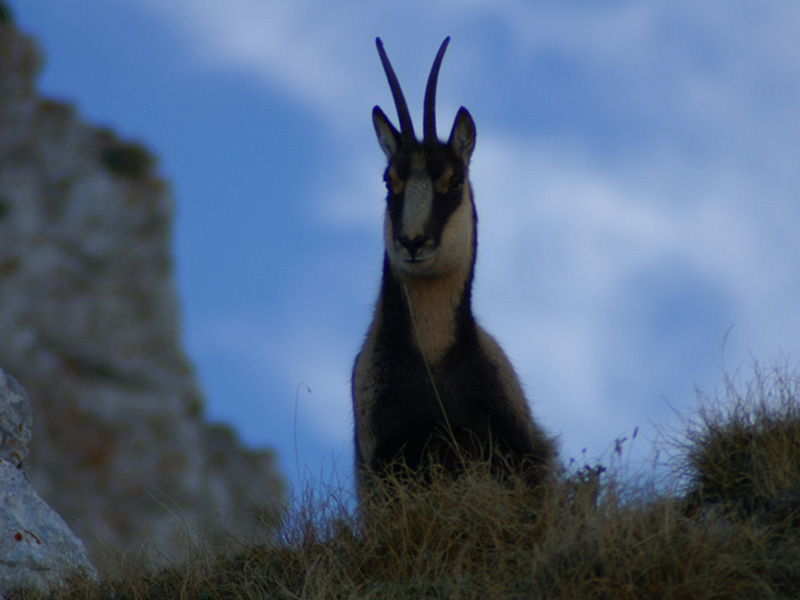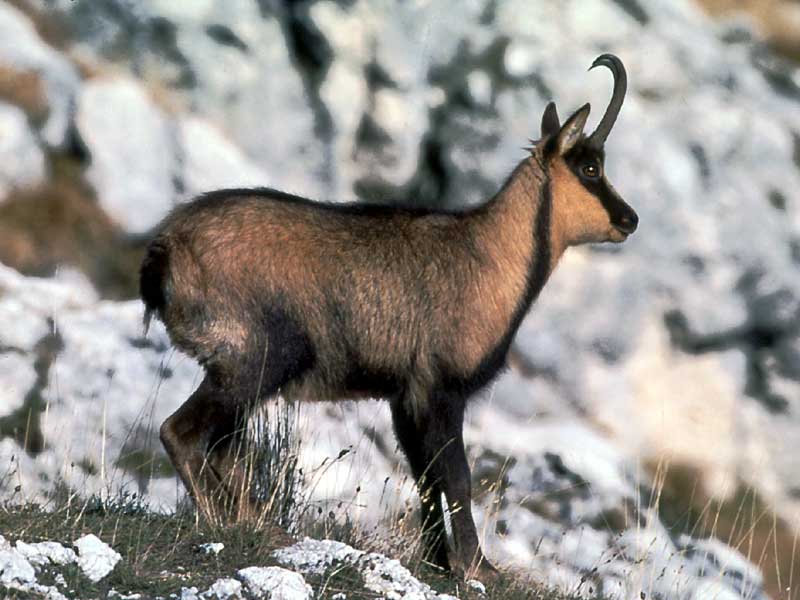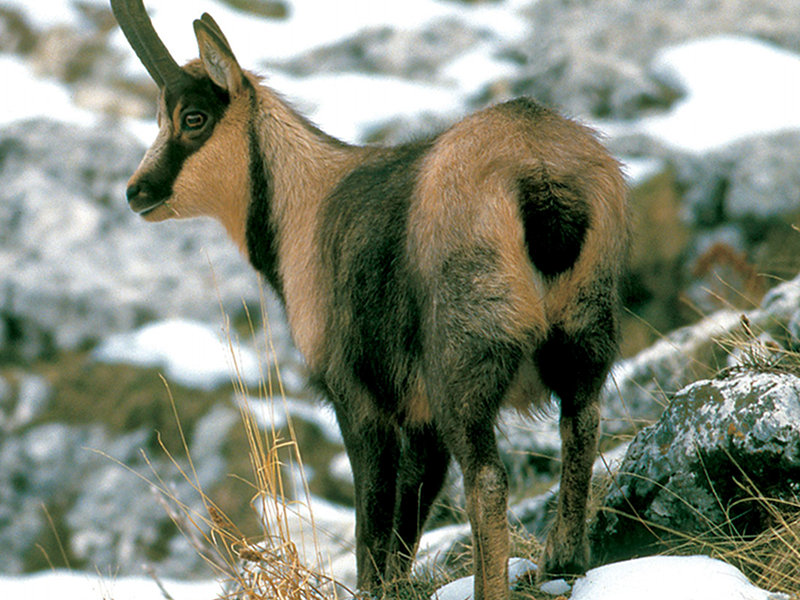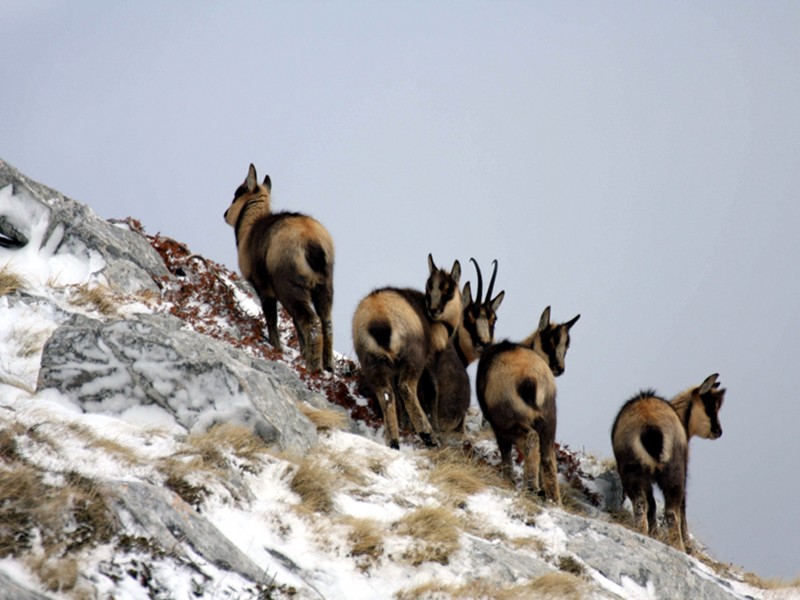Home » Territory, Nature » Fauna » Large mammals
The Apennine chamois
Name of the species: Rupicapra pyrenaica ornata
General distribution of the species at European and national level.
Population's evolution
According to genetic, morphological, paleontological and behavioral studies, the Rupicapra pyrenaica ornata is considered an independent subspecies which differs from the Alpine chamois. The Rupicapra pyrenaica ornata can be found only in Italy, and its present distribution area is extremely small in comparison with that occupied in the Holocene, when also the central-southern Apennine chain, between the Sibillini Mounts (The Marches and Umbria) and the Pollino Massif (Calabria) was included. Then, due to the hunting practices and the impacts caused by the livestock breeding, the Rupicapra pyrenaica ornata units were slowly isolated and then disappeared.
After its extinction on the Gran Sasso in 1890, only one population remained in the area which would become the Abruzzi National Park in 1922. Since 1990 two new communities of Rupicapra pyrenaica ornata have been formed in the new Majella and Gran Sasso and Laga Mountains National Parks.
Rupicapra pyrenaica ornata (Apennine chamois) conservation project (Italian Text)
Population dimension
The Rupicapra pyrenaica ornata's population of the Gran Sasso consists of about 200 individuals, and that of Majella has more or less the same dimension.
One of the priority and fundamental measures to safeguard this species is to establish and boost new vital colonies in the course of time. Through these measures they will be able to provide subjects for the creation of new units in the other areas of the Apennine that still have suitable conditions, or to supplement the original colony in the Abruzzi, Lazio and Molise National Park, which is still vulnerable despite the conservation and monitoring measures. ![]() Map of the distribution of the Apennine chamois in the Gran Sasso and Laga Mountains National Park (237Kb)
Map of the distribution of the Apennine chamois in the Gran Sasso and Laga Mountains National Park (237Kb)
Biology, ecology and ethology
Summer pastures and wintering grounds
Throughout the year the Apennine chamois frequents two different area: one estivation area and one wintering area. The former is occupied from spring to autumn depending on the climate and snow conditions, and it usually consists in high altitude grasslands situated at altitudes of 1,700 to 1,800 m alternating with flat areas and cliffs. The latter is frequented by this animal from autumn to spring, and it is made of less open areas at lower altitudes, broad-leaved tree forests and, occasionally, mixed forests with conifers at an altitude of 1,500 - 1,600 m.
Chamois usually prefer steep slopes where snow does not accumulate and flat areas and protruding rocks are also present, so that they can find food even in the snow-covered ground and a more effective shelter against their predator's attacks.
The rhythms of the chamois change throughout the day depending on the season and on the weather conditions, and they are strictly connected with the animal's physiological status (age, gender, pregnancy), the duration of the daytime and the temperature.
The feeding periods alternate with the sleeping ones, during which the rumination and the social behaviors take place and the chamois move.
During pregnancy, in a warm late-spring day, chamois usually eat in the very early morning to rest and ruminate in the shadow during the rest of the day; in the late afternoon they start grazing again until late night.
During the short winter days the activity of the herd focuses on the grazing, which is made difficult by the snow.
They usually eat in the central part of the day and is suspended only for short periods.
Nursery schools on the cliffs
In spring the impregnated females isolate themselves on the steep and woody areas representing the delivery zones. In late May the young chamois are born, in number of one or maximum two individuals. Chamois form the so-called "nursery schools", that is groups consisting of one or a few adult females that alternate with the other mothers to rise the kids in order to eat easier, without being busy with breastfeeding and controlling the kids.
Kids soon learn how to follow their mothers and take shelter in the steepest and most unreachable rocky slopes to escape from wolves' and eagles' attacks. They soon join the herd composed by the adult females with the kids, to graze and romp in the high-altitude grasslands.
The choice of the most nutritious pastures
Recent studies have analyzed the summer diet of the herds consisting of females, kids and young adults of this species. Most of the grazed grasslands belong to a typical plant community which is very rare in the Apennines and most common in the Alps, including herbaceous species developing at an altitude of more than 1,800 meters and especially in the areas facing north and east. This usually represents the typical vegetation of the snowmelt valleys and of the not steep slopes where snow accumulates for a long time. These grasslands feature several species of Gramineae and Leguminosae particularly rich in proteins and with a remarkable nourishing value. These pastures are well known by the shepherds working on the Gran Sasso and on the Laga Mountains; the great protein availability of this plant community can cause serious meteorism problems that can lead entire herds to death. For this reason the shepherds avoid these areas in early summer or when they are still wet. In early summer, chamois usually feed on species rich in phosphorus and crude proteins, that are really important for breastfeeding of kids and for their growth. In late summer their diet mainly includes calcium, magnesium and fibrous elements. Adult males do not have particular food needs, and they are satisfied with less rich pastures.
The mating season
In late summer, the adult males usually spending the rest of the year alone or in small groups join the herds composed by females and kids. From this time on, both the courting and the competition between males gradually begins, until mid-November, when the females are in their estrus period and are ready to accept males. The fightings, the chase and the other competitive actions between males depend on the age and strength of each individual, usually over 4 - 6 years of age. It often happens that groups of females take shape and are defended by only one male which constantly controls their status and keeps the other male competitors away. The young rivals are usually chased for a few meters, whereas males are chased for much longer distances. During this delicate period and in winter, chamois are more vulnerable towards the usual predators. On the Apennines, among the most dangerous predators for the chamois there are the wolf, mainly acting in winter, and the golden eagle, which tends to grab the kids. Less frequently the bear suddenly attacks single individuals. Also foxes could represent a potential danger for the young chamois, as well as dogs, whose disturbing actions have quiet serious consequences.














